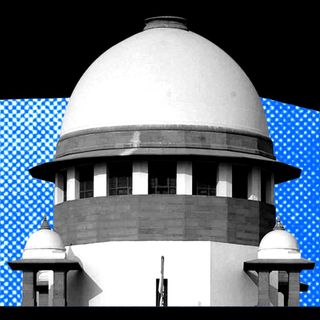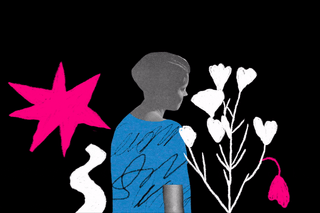
How Asexuality Is the Quiet Queer Revolution
Mainstreaming asexuality decenters our fixation with sex — and the way in which it organizes the world.

“[Y]ou’ve got to go through a lot of sex to get to anti-sex.”
Here’s a thought experiment conceptualized by a Redditor: what would happen if all allosexual people became asexual, and vice versa?
The answers are telling. “Honestly there would be a lot more respect in relationships,” opined one user. “Magazines will finally start talking about interesting topics!!!” said another.
Others predict a form of reverse-oppression, where an allosexual minority would be stigmatized – even criminalized – for their desires. Some are downright dystopic: “The world wouldn’t be better… rape may actually happen more as people try to force sexual attraction to come back,” noted one asexual person – comparing how this already happens to ace people today.
The varied responses all point to different aspects of how our culture grapples with sexuality as a whole. Our hang-ups around sex make relationships unequal and unsafe; popular culture becomes oversaturated and, dare we say, boring; people are pathologized on the basis of their desires (or lack thereof); and finally, violence is a means of imposing subjugation through sex.
What if we start decentering sex? This is the radical question we are forced to confront once we start recognising asexuality as a real identity deserving of space in this world – one that makes it queer for how it subverts normative sexuality, and dares to imagine a world where we free ourselves of its baggage entirely.
All of this is to say: asexuality is radical, queer, and can reshape the world.
Related on The Swaddle:
How Asexual People Feel Excluded From Queer Spaces, Complicating Their Identity
“Nobody has sexual freedom until all of us are free to be sexual (to experience a sexual subjectivity independent of sexual contact) — or not, however we feel, however it suits us, and whenever it suits us,” writes CJ DeLuzio Chasin in a paper published in Feminist Studies. It cuts to the heart of why asexuality has liberatory potential. As a “self-contained sexuality,” as some have put it, it emphasizes at its core the need for reclaiming sexual agency – in a form that doesn’t assume sex as a given.
Take, for instance, the adage that sex sells. It oversaturates media and consumption – such that sex is commodified and transactional, changing how people view their own bodies and by extension, senses of self. It’s based on the assumption that everyone is fundamentally interested in sex – having it, watching it, getting influenced by it. It’s an interest that’s been dialed up and turned against us on an industrial scale. Mainstreaming an asexual consciousness wouldn’t just subvert this – it would help reclaim sexuality to be as self-contained, diverse, and fluid as individuals want them to be.
Asexuality as an idea, moreover, disrupts some fundamental assumptions about the world. Take the term “sexual orientation” itself – used to signify whom one is attracted to. What of those who are not oriented sexually at all?
Many even advocate for asexual theory – one that doesn’t study asexuality, but studies from the vantage point of asexuality.
Despite all this, asexuality remains marginalized even within queer circles, where this is a question that informs much organizing and thinking.
Think, for instance, how many aspects of life are guided by the assumption of sexual desire and consequently, sexual performance. Sexual desirability can be racist, classist, and exclusionary – it sorts people into a hierarchy. Sexual performance is imposed, loaded with commodifying the self with commodities sold by whole industries devoted to it. Cosmetics, clothing, surgery, and even pharmaceuticals are dedicated to improving the performative aspect of sexuality. Spaces are designed with the intent to facilitate sexual engagement.
The primacy of sex categorizes relationships into those delineated by the presence or absence of sex – such as strict lines of separation between friends and lovers. Even marriage is an institution predicated upon the assumption of procreative (and recreative) sex between two people in perpetuity. Given how much sex orders the way we live – in what some have called “compulsory eroticism” – asexuality is a starting point for questioning sex itself as a social construct. When we start from there, we begin to encounter a feminism and queerness that disrupts the status quo even further.
Related on The Swaddle:
Asexuality Is a Sexual Orientation, Not A Disorder
“Our experiences with sexuality have not been congruent with our feminist values… As we became aware of this in ourselves, we became painfully aware of how we were being objectified by others. Asexuality is an outgrowth of this consciousness,” declares Lisa Orlando, who wrote the manifesto on asexuality. Orlando lays out the many sexual myths that dictate how people conduct their relationships. One such myth is that a sex drive is innate to human nature; others include positioning sex as the ultimate expression of closeness or love in a relationship. These, one way or another, lead to coercive sex – one that no one person may be enforcing, but many people are subject to, inevitably resulting in sexual experiences that are hurtful and even harmful.
An asexual consciousness recognizes that none of these are innately true of human beings: that relationships can be enriching and close without sex, and happiness is possible without relating to another person sexually.
“Asexuality does not merely demand that other people accept the relationships that asexuals have with each other. Asexuality demands that other people, even those who are not themselves asexual, actively participate different kinds of relationships,” says a member of an asexuality forum.
Though largely neglected from queer and feminist theory, a few scholars from within the asexual community have begun to ask: is this neglect based on fear? “Asexuality encourages us to rethink the centrality of sex to feminist and queer politics, and to consider critically what has been at stake in the neglect of asexual articulations and perspectives by queer theory and the feminist movement,” say Ela Przybylo and Danielle Cooper, two asexual queer theorists.
“But it is less that queerness should be expanded or revised to include asexuality than that queerness should be reworked and rethought from asexual perspectives,” they add.
An asexual consciousness, then, can even be politically subversive. Asexuality helps identify how sex is regulated, sanctioned, imposed, and used as an instrument of control. And in helping us get there, it liberates not just asexual people, but all people who grapple with sexuality itself. Which is to say: everyone.
Rohitha Naraharisetty is a Senior Associate Editor at The Swaddle. She writes about the intersection of gender, caste, social movements, and pop culture. She can be found on Instagram at @rohitha_97 or on Twitter at @romimacaronii.
Related


Minors Engaging in ‘Mutual Acts of Love’ Not Sexual Assault: Meghalaya HC
